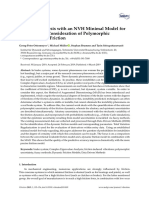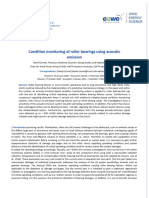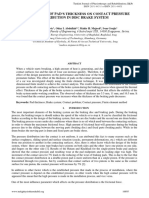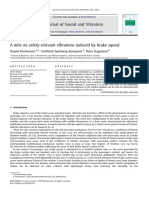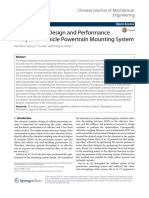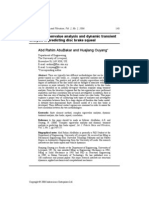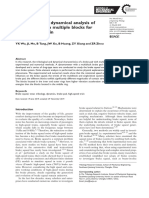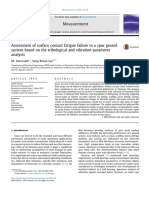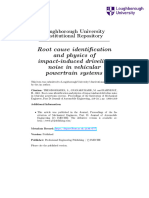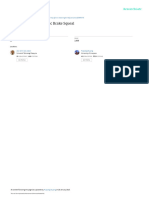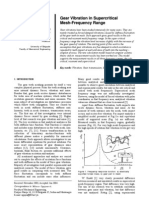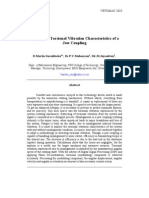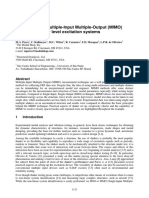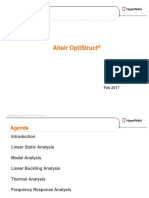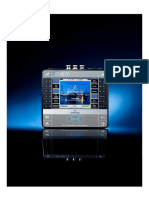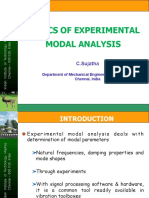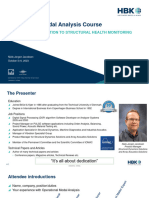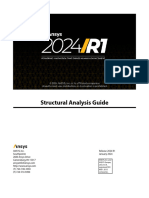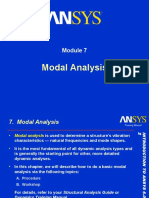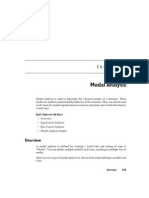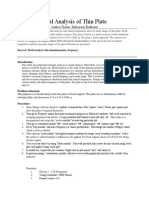A11v26n3 PDF
A11v26n3 PDF
Uploaded by
Loredana MagdaCopyright:
Available Formats
A11v26n3 PDF
A11v26n3 PDF
Uploaded by
Loredana MagdaOriginal Title
Copyright
Available Formats
Share this document
Did you find this document useful?
Is this content inappropriate?
Copyright:
Available Formats
A11v26n3 PDF
A11v26n3 PDF
Uploaded by
Loredana MagdaCopyright:
Available Formats
M.
Triches Jr et al
M. Triches Jr, S. N. Y. Gerges
and R. Jordan
Federal University of Santa Catarina
Mechanical Engineering Department
Campus Universitario, Trindade
P.O. 476
88040-900 Florianpolis, SC. Brazil
mario@emc.ufsc.br
samir@emc.ufsc.br
jordan@emc.ufsc.br
Reduction of Squeal Noise from Disc
Brake Systems Using Constrained
Layer Damping
Squeal noise generation during braking is a complicated dynamic problem which
automobile manufacturers have confronted for decades. Customer complaints result in
significant yearly warranty costs. More importantly, customer dissatisfaction may result in
rejection of certain brands of brake systems. In order to produce quality automobiles that
can compete in todays marketplace, the occurrence of disc brake squeal noise must be
reduced. The addition of a constrained layer material to brake pads is commonly utilized
as a means of introducing additional damping to the brake system. Additional damping is
one way to reduce vibration at resonance, and hence, squeal noise. The simulation of
braking events in dynamometers has typically been the preferred insulator selection
process. However, this method is costly, time consuming and often does not provide an
insight into the mechanism of squeal noise generation. This work demonstrates the use of
modal analysis techniques to select brake dampers for reducing braking squeal. The
proposed methodology reduces significantly the insulator selection time and allows an
optimized use of the brake dynamometer to validate selected insulators.
Keywords: Brake, damping, squeal, noise
Introduction
Disc brake noise is an ongoing problem for the automotive
industry. Brake noise is perceived by customers as both annoying
and an indication of a problem with the brake system. In most cases,
this type of noise has little or no effect on the performance of the
brake system. However, its perception dramatically affects quality
and satisfaction ratings as well as warranty costs. This is the reason
why the automotive industry is looking for ways to control it.1
Considerable effort has been directed at investigation and
reduction of disc brake noise. Most of this work has been performed
on problem brake systems whose design is finalized (Triches et al.,
2002). In these cases, the only solution available is the application
of noise control methods. As a consequence, add-on noise control
treatments have become a very common technique in reducing the
brake noise problem. However, the application of these treatments is
sometimes regarded as an iterative procedure, where the effects of a
huge matrix are evaluated on a structure experimentally.
In most cases, the iterative procedure to select an appropriate
noise control treatment for brake noise problems involves the use of
an inertial brake dynamometer. This procedure, however, is costly
and time consuming, because of the interaction between the
properties of damping materials (i.e. loss factor and shear modulus)
and the resonant response of the brake assembly (shoe and lining,
rotor and caliper).
In contrast, the design of effective noise control modifications to
reduce the brake noise problem can be achieved efficiently using
existing experimental techniques and methodologies. The first step
is to define the dynamic characteristics of the brake system in terms
of noise generation, identifying the source and the mechanism of the
audible noise emissions (Papinniemi et al., 2002). Once these
characteristics are understood, a suitable damping material to reduce
a specific brake noise problem can be selected using experimental
techniques and material damping knowledge.
This paper is concerned with describing the application of modal
analysis tools and damping materials knowledge to select a suitable
brake noise insulator to reduce the squeal noise problem. This
methodology is applied to a particular brake system and the results
obtained are presented. This approach is validated through new
dynamometer tests, with the selected damping material applied to
the brake system.
There are several categories of brake noise that are classified
according to the frequency of noise occurrence. Basically, there are
three general categories of brake noise: low frequency noise, low
frequency squeal and high frequency squeal (Dunlap et al., 1999).
Low frequency disc brake noise is a problem that typically occurs in
the frequency range between 100 and 1000 Hz. Typical examples of
noise problems from this category are groan and moan noise. The
generation mechanism of this kind of problem is the friction
excitation at the rotor and lining material, which provides energy to
the system. This energy is transmitted as a vibratory response
through the brake assembly and couples with components of the
suspension and chassis.
Although the low frequency noise is an important problem for
certain types of brake systems, the most common and annoying
problem is squeal noise (Dunlap et al, 1999). Squeal is defined as a
noise whose frequency content is 1000 Hz or higher that occurs
when a system experiences very high amplitude mechanical
vibrations. There are two theories that try to explain how this
phenomenon occurs. The first one is called stick-slip. According
to this theory, squeal is a self-excited vibration of the brake system
caused as a result of two factors: the static friction coefficient is
greater than the sliding friction coefficient; the relationship between
sliding friction coefficient f and relative sliding velocity Vr is
f Vr < 0 . However, this theory cannot explain why the
tendency of squeal is different when the same friction couple pair
(rotor and pads) is used in different brake systems (Chung et al.,
2001). Therefore, a second theory, called sprag-slip, was
developed. It demonstrates that the self-excited vibration of the
brake system and the high levels of vibration result from an
improper selection of geometric parameters of the brake system. In
this case, two system modes that are geometrically matched move
closer in frequency as the friction coefficient increases. These two
modes eventually couple at the same frequency and matching mode
shapes, becoming unstable (Dihua and Dongying, 1998). Both
theories attribute the brake system vibration and consequent noise to
variable friction forces at the pad-rotor interface. These variable
friction forces introduce energy into the system. During the squeal
event, the system is not able to dissipate part of this energy and the
result is the high level in the amplitude of vibration.
Paper accepted August, 2004. Technical Editor: Atila P. Silva Freire.
340 / Vol. XXVI, No. 3, July-September 2004
ABCM
Reduction of Squeal Noise from Disc Brake Systems Using
These two theories have been investigated and discussed by
researchers, but previous brake squeal experience and the majority
of research literature considers the geometric instability to be the
major mechanism of generation of brake squeal (Abdelhamid et al.,
2001).
There are two types of brake squeal: low frequency and high
frequency squeal. The difference between them is the mode shapes
involved in the modal coupling mechanism. For the low frequency
squeal, the modal coupling occurs between the out-of-plane modes
of the rotor and bending modes of the brake pad. For the high
frequency squeal, the modal coupling occurs between the in-plane
modes of the rotor. The brake rotor is much stiffer in the in-plane
direction than in the out-of-plane direction. Therefore, the resonance
frequencies of the in-plane modes of the brake rotor are higher than
those of the out-of-plane (bending) modes. Figure 1 shows the
coupling possibilities between brake components.
Figure 2. Components of an inertial dynamometer.
Measurements were taken for brake temperatures between 50
and 300 C. The braking pressure varied from 5 to 40 bar. The
acquisition system stored the data of the brake events in blocks with
the same temperature and pressure conditions, allowing a
comparison between the different conditions to find regions of
temperature and pressure where the noise occurs.
Each brake event lasts approximately 10 seconds. During this
period, data were sampled in a certain number of autospectra of the
microphone signal. The Sound Pressure Level (SPL) reported for
each brake event is the maximum value measured among all
autospectra.
Figure 1. Coupling possibilities between brake components.
Typically, the high frequency squeal occurs for frequency
ranges between 8 and 16 kHz, while low frequency squeal occurs
between 1 and 7 kHz. Since the human ear is most sensitive to the
frequency region between 1 and 4 kHz, the low frequency squeal is
considered the most annoying type of brake noise.
For these reasons, this paper attempts to evaluate control
methods for the low frequency squeal problem using damping
materials, and also procedures for selecting an appropriate damping
material to fix a particular problem of low frequency squeal in an
existing disc brake system.
Characterization of Brake Noise Generation
Perhaps one of the most important pieces of information from
brake systems is the characterization of the noise generation via
dynamometer or vehicle testing. Tests on vehicles are very
imprecise, because it is impossible to control the variables like
velocity, brake pressure and temperature in order to produce results
that represent the characteristics of brake noise generation. On the
other hand, dynamometer tests allow us to approach the real
behavior of a brake system in practice, controlling parameters such
as rotation, braking pressure and temperature while recording the
sound pressure level and frequency of noise occurrences. The disc
rotation is achieved by electric motors connected to a shaft with
inertial wheels, simulating the inertia effects of the vehicle. Figure 2
shows of the components of an inertial brake dynamometer.
J. of the Braz. Soc. of Mech. Sci. & Eng.
Figure 3. Noise occurrences obtained with dynamometer test.
Figure 3 shows the results obtained for the baseline brake
system, i.e, without any modification to its components. The
dynamometer results show a strong noise frequency around 7 kHz,
together with other peaks across the whole frequency range.
However, the number of occurrences and the amplitude of the SPL
peak indicate that the noise at 7 kHz is the most important problem
in this particular brake system under investigation. Figure 4 shows a
noise map obtained with the dynamometer test. It can be seen that
the highest SPL peak occurs for a frequency around 7 kHz, for a
temperature around 150 C and for a pressure of 25 bar. This kind of
Copyright 2004 by ABCM
July-September 2004, Vol. XXVI, No. 3 / 341
M. Triches Jr et al
information is important to identify which class of noise problem is
responsible for the high noise levels from the brake system.
Figure 5. Example of excitation autospectra used in the modal testing
procedure.
Figure 4. Noise map for baseline brake system.
The next step is to determine the modal behavior of each brake
component to verify whether any component has a resonance
frequency near 7 kHz, and more importantly, to detect potential
modal couplings between them. Therefore, a modal analysis
procedure is applied for each component, i.e, rotor, pads and caliper,
and the natural frequencies and mode shapes of these components
are obtained.
Characterization of the Dynamics of Brake Components
Squeal noise occurs only when the brake system components
demonstrate resonance vibrations (Boss and Balvedi, 2001).
Therefore, it is very important to determine the modal behavior of
the components to understand the problem.
Modal analysis of individual components allows us to gain an
insight into potential coupling modes, which is, as mentioned
before, one of the causes of squeal noise generation. In order to
obtain the modal parameters of brake components, each one is
modeled through a mathematical mesh to represent its geometry.
Pad, rotor and caliper Frequency Response Functions (FRFs)
were measured by exciting each component with an impact hammer
and measuring the acceleration response with a small accelerometer.
Then, the FRFs were processed by CADA-X software in order to
identify the modal parameters, i.e, resonance frequencies, modal
shapes and damping values.
Modal Analysis of Brake Pads
The excitation was provided by a small impact hammer (PCB
086D02), with sensitivity of 22 mV/N and with a hard tip to achieve
frequencies up to 16 kHz (see Figure 5). In order to avoid errors due
to the effect of transducers in the dynamic properties of the brake
pads (additional mass), a light small accelerometer (PCB 352B10),
with sensitivity of 10 mV/g, was used to obtain the acceleration
response. The accelerometer was kept at a fixed point (see Figure 6)
and the excitation was applied at all points (roving method). The
analysis was carried with 4096 data points, 16384 kHz of maximum
frequency and frequency resolution of 4 Hz. An exponential time
weighting function (window) was used for the response signal (5%
decay and damping correction) and a transient window was used for
the force signal. The modal parameters were extracted using the
time domain method (least squares complex). Figure 7 shows the
mode shapes and Table 1 presents the resonance frequencies and the
damping loss factors obtained for the brake pad.
Figure 6. Mesh used for modal testing procedure of the brake pad.
The modal analysis of brake pads is perhaps the most important
process to understand in order to find solutions for the disc brake
noise problem. Some properties like loss factor, natural frequencies
and mode shapes of brake pads are crucial in defining which type of
brake noise problem may occur.
The brake pad was supported by two slender cables in order to
simulate a free-free boundary condition. The free-free condition
allows the structure to vibrate without interference from other parts,
making the visualization easier of mode shapes associated with each
natural frequency. Moreover, in this case, the rigid body oscillation
frequency of the assembly (suspended pads) is much lower than the
first natural frequency of the structure (pad). For instance, the
assembly rigid body frequency is around 5 Hz, while the first
natural frequency of the brake pad occurs around 2600 Hz.
Figure 7. Mode shapes for brake pad.
The mode shapes for the brake pad are very similar to bending
and twisting modes of beams. The pad length is longer than the
width. As a consequence, the bending modes along the longer edge
occur first. From the modal coupling point of view, the bending
modes are more important than the twisting modes. In most cases,
342 / Vol. XXVI, No. 3, July-September 2004
ABCM
Reduction of Squeal Noise from Disc Brake Systems Using
the modal coupling occurs between pad and disc bending modes,
since the disc does not have a defined shape for twisting modes.
Table 1. Modal parameters obtained for brake pad.
Vibration
Mode
1
2
3
4
5
Resonance
Frequency (Hz)
2620
3757
6650
7153
8623
Mode shape
1 st bending
2nd bending
3rd bending
1 st twisting
2nd twisting
Damping Loss
Factor (%)
0.678
0.646
0.641
1.052
0.448
Modal Analysis of Disc
In the same way as that for the brake pad, the modal analysis of
the disc was carried out. The mesh was constructed with 111 points
to avoid space aliasing. During the measurements, the rotor was
supported by a foam block, in order to simulate a free-free boundary
condition. Experiments show that analysis with fixed boundary
conditions, i.e, disc fixed on the brake knuckle by bolts, generates
mode shapes very close in form to the mode shapes obtained for the
rotor in the free-free condition.
The disc mesh represents only the border, because the disc hat
and bolt area can be considered without influence on the coupling
mechanism. Furthermore, the mode shapes found for these regions
are located at high frequencies, beyond the frequency range of
interest for the analysis of potential coupling modes. Figure 8 shows
the modal shapes and Table 2 presents the natural frequencies and
damping loss factors obtained for the brake disc in normal direction.
of this study, is sufficient. For this case, a modal analysis in normal
direction is enough.
The pad presents less vibration modes than the disc, over the
same frequency range. Furthermore, the damping loss factor values
associated with the pad vibration modes are higher than those of the
rotor, because the friction material provides considerably more
damping than the cast steel used in the disc. As a consequence, there
is a tendency for the disc modes to be the major determinant of the
squeal frequency.
Table 2. Modal parameters obtained for brake disc.
Vibration
Mode
1
3
6
10
13
Resonance
Frequency (Hz)
1090
2210
3600
5320
7320
Mode
Damping Loss
shape
Factor (%)
2nd bending
0.247
3rd bending
0.128
4th bending
0.108
5th bending
0.130
6th bending
0.176
As mentioned before, squeal noise usually occurs whenever a
number of brake components, such as pad and disc, start to vibrate
together, creating a coupled system mode. Considering the bending
modes coupling, when the components have the same wavelength
and frequency, they will be geometrically matched and will vibrate
in phase (Fieldhouse, 1999). In this case, the friction damping is
minimized and the system works as a loudspeaker, radiating sound.
Analyzing the results obtained with the modal analysis of brake
components together with their geometry, it can be noticed that the
third bending mode of the brake pad and the sixth bending mode of
the disc can couple and create a system mode. The third bending
mode of the pad has a resonance frequency around 6650 Hz, while
the disc resonance occurs at 7320 Hz for the sixth bending mode.
The wavelength for the pad mode is approximately 100 mm and for
the disc is 112 mm, considering these two bending modes, as shown
in Figure 9.
Figure 9. Wavelength coincidence between disc and pad.
Thus, there is a wavelength coincidence between pad and disc in
this situation, leading to the appearance of a coupled mode. Figure
10 shows an overlap between third pad bending mode and the sixth
disc bending mode.
Figure 8. Mode shapes for brake disc.
The excitation was provided by an impact hammer in the normal
direction. For this reason only the bending modes were obtained by
this modal analysis. To obtain the modal parameters in the
tangential direction, a new procedure is necessary. However, this
paper addresses only modal coupling in the normal direction, i.e.,
between bending modes of the disc and pads, which, for the purpose
J. of the Braz. Soc. of Mech. Sci. & Eng.
Copyright 2004 by ABCM
July-September 2004, Vol. XXVI, No. 3 / 343
M. Triches Jr et al
As a consequence, for high pressures, the third bending mode of
the pad and the sixth bending mode of the rotor can start do vibrate
together in a coupled mode. This fact is in accordance with Figure 4,
which shows noise occurrence at higher pressures.
The effect of the braking pressure can be analyzed in terms of
standing and traveling waves on the brake rotor. For the system here
analyzed, at low pressures, rotor and pads are barely in contact. As
contact pressure increases, the vibration amplitude peaks (on the
mode shape) start to move with respect to the pads. In this case,
there is a traveling wave in the disc. At high pressures, rotor and pad
modes start vibrating in phase. In this situation, the anti-nodes no
longer rotate, but remain in the same position along the rotor
diameter, characterizing a standing wave.
Behavior of Brake Components in Relation to Temperature
Figure 10. Modal coupling between modes of pad and disc.
Figure 11 shows a comparison between two frequency response
functions, measured for rotor and pad. The third bending mode of
the pad and the sixty bending mode of the disc are pointed out on
the graph.
Figure 11. Frequency response functions for rotor and pad.
Behavior of Brake Components Under Pressure
It should be noticed that the resonance frequency of the two
modes involved in the potential coupling is slightly different.
However, when the brake system works under pressure and
temperature, the dynamics of the brake components are changed
significantly. This behavior is more pronounced for the pad than for
the disc, because of the friction material. The disc is made of cast
iron while the brake pad has a significant proportion of friction
material, which can be compressed by the brake pressure. Due to
this compression, the stiffness of the pad is increased, moving the
resonances to higher frequencies. On the other hand, the brake
pressure has little influence over the disc. Therefore, the resonance
frequencies of these two components change at different rates when
brake pressure is applied (Triches et al., 2002), as shown in Figure
12.
Region of
coupling
Pad (100C)
Resonance Frequency
Rotor (100C)
Braking Pressure
Figure 12. Influence of pressure on modes of disc and pad.
344 / Vol. XXVI, No. 3, July-September 2004
Temperature has an effect similar to pressure. However, an
increase in temperature causes a reduction in the stiffness of brake
components. As a result, the resonance frequency of the brake
components tends to decrease. In the same way as that for brake
pressure, the effect of temperature is more important for the brake
pad, again due to the presence of friction material. Figure 13 shows
this effect for the brake pad resonance frequencies, considering the
first and second bending modes.
Figure 13. Influence of temperature on modes of disc and pad.
For high temperatures, the third bending mode of the pad and
the sixth bending mode of the disc tend to mismatch. Consequently,
the modal coupling between these two modes doesnt occur and
squeal noise is not radiated. This also fact conforms with Figure 4,
which shows that the high sound pressure levels appear for low
temperatures and for high pressures.
Once the squeal noise mechanism is identified and the vibration
modes involved in the problem are detected, noise control
possibilities can be tested.
Constrained Layer Material
Low frequency brake squeal noise is due to the coupling
between the bending modes of vibration of the disc and the pad.
When the two components, disc and pad, start to vibrate together,
the system damping for that specific system resonance is reduced,
since the joint damping between pad and disc decreases (Balvedi et
al., 2002). As a consequence, the friction forces may introduce more
energy into the system than it can dissipate.
This class of squeal noise can be avoided with adequate design
of the components, keeping the resonances apart. For this, changes
in the geometry of the pad, like chamfers and slots, or changes in the
mechanical properties of the components (stiffness, mass) can avoid
possible modal couplings.
Nevertheless, the modal coupling mechanism is also influenced
by the boundary conditions of the system, especially braking
pressure and temperature, as mentioned before.
ABCM
Loss Factor
One can conclude that, even with changes in the geometry of the
pad, pressure and temperature may contribute to the coupling of the
same modes in a different boundary condition. Even more likely,
modes formerly uncoupled may have closer frequencies and
matched wavelengths, generating squeal at a different frequency.
In summary, modifications in geometry and material properties
are not always effective to control this category of squeal noise. If
the system generates more energy than can be dissipated, increasing
the system damping can control the noise radiated. This additional
damping can be obtained using constrained layer damping materials
(called insulators).
Shear Storage Modulus
Reduction of Squeal Noise from Disc Brake Systems Using
G
Rubbery Region
Transition Region
Glassy Region
Brake noise insulators consist of a sandwich of two steel plates
separated by a viscoelastic or a rubber core, as seen in Figure 14,
and its application to control brake noise has become one of the
most efficient solutions. The insulator is very thin and it is bonded
or mechanically attached to the pad backplate.
When the pad vibrates in the bending modes, a constrained layer
material with a viscoelastic core bonded onto the pad backplate is
submitted to mechanical deformations, converting part of the energy
into heat by shear damping (Reddy, 1997), reducing the vibration
amplitude of the component (see Figure 15).
Loss Factor
Figure 14. Brake noise insulators.
Shear Storage Modulus
Frequency
Glassy Region
Transition Region
Rubbery Region
Temperature
Figure 16. Effect of temperature and frequency on the properties of
viscoelastic materials, where G is the storage modulus (real part of the
complex modulus) measured for shear deformation (Jones, 2001).
Considering the dynamometer tests, for the particular brake
system here analyzed, squeal noise occurs at a frequency around
7000 Hz, and within temperature and pressure ranges of 150 175
C and 25 30 bar, respectively. Therefore, the proposed insulator
must have a good performance under these conditions.
Figure 15. Shear damping in constrained laminated materials.
Selection of Insulators
As previously stated, due to the behavior of friction material,
brake pressure and temperature have a great influence on the
characterization of the pad vibration modes and on its natural
frequencies (Triches et al., 2002). So, for a brake system, the
occurrence of squeal is a variable dependent on these two
parameters. Other important point is that the viscoelastic or rubber
material, which is used in the constrained layer, also has properties
highly dependent on pressure, temperature and frequency. Youngs
Storage Modulus characteristically decreases with an increase in
temperature, while the loss factor reaches its maximum value at the
transition temperature (Ungar et al., 1972), as shown in Figure 16.
Frequency can have different effects, depending on the temperature
region studied. In general, the loss factor tends to be proportional to
frequency in the rubbery region, reach its maximum value in the
transition region and tends to be inversely proportional to frequency
in the glassy region. Pressure affects the phenomena of relaxation
and recovery of the chains of polymers, changing the dynamic
behavior of the viscoelastic materials. Therefore, the suitable
damping material selected must be appropriate for the conditions
under which squeal occurs.
J. of the Braz. Soc. of Mech. Sci. & Eng.
The classical method for selecting an insulator to reduce the
squeal noise problem is the simulation of the brake event in an
inertial dynamometer. A set of insulators is tested and the results are
analyzed. The insulator which presents the best noise reduction is
chosen. However, this method is very expensive and time
consuming. Besides that, it doesnt provide an insight into the
mechanism of squeal noise generation.
This paper presents a methodology for selecting an insulator
based on modal screening. The proposed methodology reduces the
insulator selection time significantly and allows for an optimum use
of the brake dynamometer to validate selected insulators. Hence, the
dynamometer is used only to validate the insulator selected by the
modal screening method, saving time and reducing costs.
Knowing the characteristics of the squeal problem (frequency,
temperature and pressure at which the noise occurs), the brake
insulator can be selected through the dynamics of the brake
components.
The purpose of brake shims is to add damping to the brake pad
and, consequently, to the whole brake system. Therefore, the
capacity of an insulator to add damping can be evaluated through
mobility measurements on the brake pad, for a range of temperature.
For this, different types of insulators were bonded to the pads and
measurements of Frequency Response Functions (FRFs) were
carried out inside an oven, to evaluate the changes in loss factor.
As previously shown, the modal coupling responsible for the
squeal noise generation occurs between the third bending mode of
the pad and the sixth bending mode of the disc. Thus, the loss factor
Copyright 2004 by ABCM
July-September 2004, Vol. XXVI, No. 3 / 345
M. Triches Jr et al
was evaluated for the third bending mode of the pad, for different
types of insulators. In order to get the loss factor, point mobility
functions were measured for a range of temperature between 75 and
300 C. Figure 17 shows the results obtained for the pad loss factor
of four types of insulators, evaluated for the third bending mode of
the pad.
Figure 18. Setup for measurement of system Frequency Response
Function (FRF) as a function of pressure.
In this way, having determined the main modes responsible for
the squeal noise generation, the system loss factor can be evaluated
for different shim configurations. Moreover, quantifying the system
loss factor makes it possible to predict the potential for squeal
occurrence and which shim fits better for a specific problem.
The point frequency responses for the disc were taken at the
same position for all measurements and for different lining
pressures, in steps of about 25 Psi and at room temperature. Figure
19 shows a waterfall plot of the frequency response functions for the
baseline system, without noise insulators.
Figure 17. Loss factor for the pads using different insulators under
temperature.
Notice that for temperatures around 150 C insulator # 2 shows
the best performance in terms of loss factor added to the brake pad.
However, the capacity of the insulators to add damping to the whole
system also needs to be verified. Thus, frequency response functions
of the assembled system were measured, evaluating the dynamic
properties of the system resonance, around the frequency of the
sixth disc bending mode. Frequency and, more importantly,
damping of this mode were measured as a function of brake
pressure. This approach allows the analysis of the performance of
the insulator under different boundary conditions of the brake
system.
Analysis of Assembled Brake System
The frequency response analysis of the assembled brake
system was performed for a determined range of brake pressure.
This technique allows the quantifying of the damping of the system
at the critical mode for each insulator configuration. This test
provides the level of damping in the system and effect on the noise
problem.
The technique consists of measuring frequency response
functions at points of disc and external pad, exciting the disc using
an impact hammer. In this experimental method, the disc remains
static. As a consequence, the friction mechanism was not taken into
account. Thus, the input energy introduced by the friction between
pad and disc is replaced by the excitation provided by the impact
hammer. This is a simplification, because in real systems the
excitation is not kept constant but varies as a function of the
boundary conditions of the brake system. However, since the
excitation provided by the frictional contact between rotor and pads
has a broadband feature, the point force provided by the impact
hammer can be used to represent the behavior of the input excitation
energy (McDaniel et al., 1999).
This technique allows the measurement of the system damping
considering exclusively the mode coupling phenomena. Figure 18
shows a sketch of the test setups.
346 / Vol. XXVI, No. 3, July-September 2004
Figure 19. Frequency response measurement on the assembled system
with baseline pads.
Observe that the resonance frequency (7200 Hz) occurs in the
vicinity of the squeal frequency measured in the dynamometer.
Notice also that the assembled brake system with pads in the
baseline condition has a system loss factor, for the mode of interest,
in the order of 0.01, which is considered low.
At very low pressures, disc and pads are barely touching and the
measured system damping is similar to the damping of the sixth
bending mode of the disc. As the pressure starts to increase, the disc
comes into contact with the pads and the system damping starts to
increase (friction damping). However, as the pressure continues to
increase, the resonance frequency of the pad increases at a higher
rate than that of the disc until both modes couple and the
components start to vibrate together in the same deformation
pattern. In the pressure range within which disc and pad start
vibrating in-phase, the system mode frequency moves down. In this
case, the system rigidity is reduced, since pads are now vibrating inphase with the disc and the most dominant effect is the pads adding
mass to the system mode. After that, for high pressures, the system
damping is dramatically reduced and the vibration amplitude
increases. This behavior is shown in Figure 20.
ABCM
Reduction of Squeal Noise from Disc Brake Systems Using
Figure 22. Noise map for brake system using noise insulators.
Furthermore, the number of noisy stops for the brake system
using noise insulators was much lower than for the baseline brake
system, as shown in Figure 23.
Figure 20. Loss factor obtained for assembled brake system.
25
Brake system with insulator # 2
Baseline brake system
20
% of noisy occurrence
Under the described conditions, it is necessary to increase the
system damping to avoid the squeal noise radiation. With this
purpose, insulator # 2 was bonded to the pad backplate and the
aforementioned procedure was repeated.
With insulator #2, the system loss factor increases (see Figure
20) and the amplitude of vibration decreases, as shown in Figure 21.
A significant gain in the system damping can be seen when
noise insulators are used, mainly in the pressure range where the
modal coupling occurs. For high pressures, the damping loss factor
had its value multiplied by three. Besides this, it is important to
remember that the frequency response measurements were carried
out at room temperature, while insulator # 2 shows the best
performance around 150 C.
15
10
Baseline brake system
0
% > 100 dB
Brake system with insulator # 2
% > 90 dB
SPL
% > 80 dB
% > 70 dB
Figure 23. Noise occurrences for brake system with insulator # 2 and for
baseline condition.
In summary, a suitable noise insulator for a particular brake
system was selected using two dynamometer tests. Furthermore, the
modal screening method allowed gaining an insight into the
mechanism of squeal noise generation.
Conclusions
Figure 21. Frequency response measurement on the assembled system
with noise insulator #2.
Therefore, for the brake system analyzed here, insulator #2
would be the best choice. To confirm the performance of the
selected insulator, new dynamometer tests were performed. The
results are shown in Figure 22, which illustrates that the noise at the
frequency around 7 kHz has lower amplitude than that for the
baseline condition, when the brake system has no noise insulators.
J. of the Braz. Soc. of Mech. Sci. & Eng.
Despite a century of developing disc brake systems, disc brake
squeal remains a largely unresolved problem. This is not to say,
however, that no progress has been made. Many experimental and
analytical studies have led to insight on the factors contributing to
brake squeal or to the amelioration of squeal in disc brakes of a
specific type or in a particular make and model of automobile.
Experimental studies have accumulated a wealth of information
about the nature of squeal, the vibration modes therein, the wear of
brake components and frictional interactions in brakes.
The design of modifications to a given brake system to control
noise has too often been regarded as a cut and paste or trial and
error procedure, where the effects of a huge matrix of
modifications is experimentally evaluated on a structure. This
approach is sometimes successful but always expensive and time
consuming. Often, no knowledge is gained even if a solution is
found.
The presented methodology proposes only two dynamometer
tests. The first test has the purpose of characterize the system,
finding sound pressure level maps (contour plots, showed in Figures
22 and 4). The final test is carried out just to validate de selected
insulator. Through the initial dynamometer test, it was verified that
squeal noise occurs in discrete tones, indicating the dependency of
the coupling modes of the brake components on the determination
of the squeal frequency. Dynamometer results also showed some
Copyright 2004 by ABCM
July-September 2004, Vol. XXVI, No. 3 / 347
M. Triches Jr et al
variation on the squeal noise frequency. This was attributed to the
strong dependency of the system braking parameters to the
operating boundary conditions of the brake system, especially
braking pressure and temperature. This phenomenon was also seen
during the static system frequency response measurements, where
the third bending mode of the pad and sixty bending mode of the
disc, originally separated by 760 Hz, moved closer as function of
braking pressure.
The modes involved in the coupling mechanism were pointed
out through modal analysis and frequency response function
measurements. Together with the information provided by the initial
dynamometer test, this experimental procedure could be applied as
an effective tool for selecting damping materials to fix a specific
problem.
The application of constrained layer materials to add damping to
the brake system can be considered as an efficient solution to reduce
the squeal noise problem. The final dynamometer test showed
reductions about 20 dB for some frequencies, in the case of the
system using the selected insulators. However, the selection of the
insulator is not a straightforward procedure and must take into
account the effects of temperature and brake pressure.
To avoid excessive time consumption with extensive
dynamometer tests (trial and error procedure), the use of modal
analysis and frequency response function measurements is
recommended, since its effectiveness was demonstrated by the
procedures shown in this paper.
Acknowledgments
The authors would like to thank Dr. Alessandro M. Balvedi, for
his helpful comments and recommendations about frequency
response measurements of the brake system under pressure, and Dr.
Sharam Tousi, for his help with the dynamometer tests. This work
was jointly supported by the Brazilian agency CNPq Conselho
Nacional de Desenvolvimento Cientifico e Tecnologico, and the
348 / Vol. XXVI, No. 3, July-September 2004
company MSC Laminates and Composites. The authors also thank
the software suppliers LMS International and Smarttech.
References
Triches, M. J. et al, Application of Constrained Layer Material on the
Reduction of Disc Brake Noise, Proc. of INTER-NOISE 2002, edited by
Ahmet Selamet, Rajendra Singh and George C Maling, Jr. (Dearborn, MI,
August 19-21, 2002).
Papinniemi, A., Lai, J. C. S., Zhao, J. and Loader, L., Brake Squeal: a
literature review, Applied Acoustics, 63, 391-400 (2002).
Dunlap, K. B., Riehle, M. A. and Longhouse, R. E., An Overview of
Automotive Disc Brake Noise, SAE Paper 1999-01-0142 (1999).
Chung, C., Steed, W., Kobayashi, K. and Nakata, H., A New Analysis
Method for Brake Squeal Part I: Theory for Modal Domain Formulation and
Stability Analysis, SAE Paper 2001-01-1600 (2001).
Dihua, G. and Dongying, J., A Study on Disc Brake Squeal Using
Finite Element Methods, SAE Paper 980597 (1998).
Abdelhamid, M. K., Blaschke P., Wang, W. A. e Yang, S., An
Overview of NVH Problems in Braking Systems, Book of 5th International
Brake Colloquium, (2001), pp. 41-47.
Boss, D. E. and Balvedi, A. M., Engineering Brake Noise Solutions,
Book of 5th International Brake Colloquium, (2001), pp. 32-35.
Fieldhouse, J. D., A Proposal to Predict the Noise Frequency of a Disc
Brake Based on the Friction Pair Interface Geometry, SAE Paper 1999-013403 (1999).
Balvedi, A. M., Gerges, S. N. Y. and Tousi, S., Identification of Brake
Squeal Noise via Sound Intensity and Acoustical Measurement, Proc. of
INTER-NOISE 2002, edited by Ahmet Selamet, Rajendra Singh and George
C Maling, Jr. (Dearborn, MI, August 19-21, 2002).
Reddy, J. N., Mechanics of Laminated Composite Plates: Theory and
Analysis (CRC Press, 1997).
Lu, Y. P., Killian, J. W. and Everstime, G. C., Vibrations of Three
Layered Damped Sandwich Plate Composites, Journal of Sound and
Vibration, 64 (1), 63-71 (1979).
Ungar, E. E., Heckl, M. and Cremer, L., Structure Borne Sound (2 nd
Edition, Springer-Verlag, Heidelberg, 1972).
Jones, D. L. G., Viscoelastic Vibration Damping, (John Wiley & Sons,
Ltd, 2001).
McDaniel, J. G., Chen, S-E., Moore, J., Clarke, C. L., Acoustic
Radiation Models of Brake Systems from Stationary LDV Measurements,
Proceedings of IMEC 99.
ABCM
You might also like
- Vibration Basics and Machine Reliability Simplified : A Practical Guide to Vibration AnalysisFrom EverandVibration Basics and Machine Reliability Simplified : A Practical Guide to Vibration AnalysisRating: 4 out of 5 stars4/5 (2)
- Reduction of Squeal Noise From Disc Brake Systems Using Constrained Layer DampingDocument9 pagesReduction of Squeal Noise From Disc Brake Systems Using Constrained Layer DampingMuhammad M ElhafidNo ratings yet
- Brake Squeal PaperDocument7 pagesBrake Squeal PaperjoshibecNo ratings yet
- Optimization of Constrained Layer Damping For Strain Energy Minimization of Vibrating PadsDocument9 pagesOptimization of Constrained Layer Damping For Strain Energy Minimization of Vibrating PadsIvan GrujicNo ratings yet
- BI31199203Document5 pagesBI31199203Dr-Nouby Mahdy GhazalyNo ratings yet
- Parametricstudiesofdiscbrakesquealusing PDFDocument16 pagesParametricstudiesofdiscbrakesquealusing PDFRajiv SarkarNo ratings yet
- Review on Thermal 7Document7 pagesReview on Thermal 7er.rkc91No ratings yet
- Optimal Automobile Muffler Vibration and Noise AnaDocument19 pagesOptimal Automobile Muffler Vibration and Noise AnaRAGULNo ratings yet
- Tyre Cavity ResonanceDocument11 pagesTyre Cavity ResonanceArjunNo ratings yet
- Brake Comfort - A ReviewDocument48 pagesBrake Comfort - A ReviewAleksandar GrkicNo ratings yet
- High Frequency Vibrations in GearboxDocument21 pagesHigh Frequency Vibrations in GearboxKAJAL BNo ratings yet
- 1-S2.0-S0888327009002672-Main - Luis EduardoDocument23 pages1-S2.0-S0888327009002672-Main - Luis EduardoLuís EduardoNo ratings yet
- Testing Methods For Vehicle Shock AbsorbersDocument12 pagesTesting Methods For Vehicle Shock AbsorbersMary Atkins100% (1)
- Zhou Et Al 2019 Vibration and Noise Characteristics of A Gear Reducer Under Different Operation ConditionsDocument18 pagesZhou Et Al 2019 Vibration and Noise Characteristics of A Gear Reducer Under Different Operation ConditionsGanesh KCNo ratings yet
- Stability Analysis With An NVH Minimal Model For BDocument22 pagesStability Analysis With An NVH Minimal Model For Bdamienky.2024No ratings yet
- Report MufflerDocument24 pagesReport MufflerVinoth KumarNo ratings yet
- Identification and Quantification of Stick-Slip Induced Brake Groan Events Using Experimental and Analytical InvestigationsDocument21 pagesIdentification and Quantification of Stick-Slip Induced Brake Groan Events Using Experimental and Analytical Investigationsthierry42No ratings yet
- Envelope BearingDocument14 pagesEnvelope BearingHussein Razaq100% (2)
- A Review of Vibration and Acoustic Measurement Methods For The Detection of Defects in Rolling Element Bearing PDFDocument12 pagesA Review of Vibration and Acoustic Measurement Methods For The Detection of Defects in Rolling Element Bearing PDFAnil MaliNo ratings yet
- Wes 6 367 2021Document10 pagesWes 6 367 202122143141No ratings yet
- The Influence of Tyre Cavity On Road NoiseDocument7 pagesThe Influence of Tyre Cavity On Road NoiseGuilherme Henrique GodoiNo ratings yet
- The Influence of Pad'S Thickness On Contact Pressure Distribution in Disc Brake SystemDocument12 pagesThe Influence of Pad'S Thickness On Contact Pressure Distribution in Disc Brake SystemOday IbraheemNo ratings yet
- Tribology International: M. Amarnath, I.R. Praveen KrishnaDocument11 pagesTribology International: M. Amarnath, I.R. Praveen KrishnaM.ThirunavukkarasuNo ratings yet
- Wsf-4 2461 ManuscriptDocument6 pagesWsf-4 2461 ManuscriptRonald GeorgeNo ratings yet
- Wear and Multiple Fault Diagnosis On Rolling Bearings Using Vibration Signal AnalysisDocument9 pagesWear and Multiple Fault Diagnosis On Rolling Bearings Using Vibration Signal AnalysisinventionjournalsNo ratings yet
- Research Article: Driveline Torsional Analysis and Clutch Damper Optimization For Reducing Gear RattleDocument25 pagesResearch Article: Driveline Torsional Analysis and Clutch Damper Optimization For Reducing Gear RattleLindsay Shantha RubiaNo ratings yet
- Thermal Deformation Analysis of Automotive Disc Brake SquealDocument26 pagesThermal Deformation Analysis of Automotive Disc Brake SquealNg Guo LiangNo ratings yet
- Sensors 21 05927 v2Document21 pagesSensors 21 05927 v2johambelsalas612No ratings yet
- (Disque) A Note On Safety-Relevant Vibrations Induced by Brake SquealDocument6 pages(Disque) A Note On Safety-Relevant Vibrations Induced by Brake SquealAhmed GHORBELNo ratings yet
- Vibration Isolation With Clutch Disk Pre-Damper Mechanism For The Idle Rattle PhenomenonDocument18 pagesVibration Isolation With Clutch Disk Pre-Damper Mechanism For The Idle Rattle PhenomenonTuna RefaioğluNo ratings yet
- Essay in VibrationDocument7 pagesEssay in VibrationReynalene PanaliganNo ratings yet
- NVH Reduction TrendsDocument22 pagesNVH Reduction TrendsDaisy BasumataryNo ratings yet
- Optimization Design and Performance Analysis of Vehicle Powertrain Mounting SystemDocument13 pagesOptimization Design and Performance Analysis of Vehicle Powertrain Mounting SystemAbdurahman MuhammadNo ratings yet
- InTech-Automotive Applications of Active Vibration ControlDocument17 pagesInTech-Automotive Applications of Active Vibration ControlShahbaz NazirNo ratings yet
- Brake Roughness - Disc Brake Torque Variation, Rotor Distortion and Vehicle ResponseDocument15 pagesBrake Roughness - Disc Brake Torque Variation, Rotor Distortion and Vehicle Responsedebisi14140100% (1)
- Ijvnv AbubakarDocument13 pagesIjvnv AbubakarJ Luis MlsNo ratings yet
- Bcg/'/Mtg/Ba by 8Az/Ax @bhag 6 (Tetvgxe/Fg/Vf Hf/Az 8Kcxe/'Xagt - "Ah'Xe/Vt - 4at - LF/FDocument19 pagesBcg/'/Mtg/Ba by 8Az/Ax @bhag 6 (Tetvgxe/Fg/Vf Hf/Az 8Kcxe/'Xagt - "Ah'Xe/Vt - 4at - LF/FSanthosh KumarNo ratings yet
- A4 Karabay Baynal Deli 2013MakaleSCDocument13 pagesA4 Karabay Baynal Deli 2013MakaleSCWinnicios RochaNo ratings yet
- Washing Machine - Vibration Control & Noise ReductionDocument6 pagesWashing Machine - Vibration Control & Noise ReductionAshley WellsNo ratings yet
- Acoustic Diagnosis of Driving Belt Physical Condition in EnclosuresDocument11 pagesAcoustic Diagnosis of Driving Belt Physical Condition in EnclosuresraminNo ratings yet
- Dr. M. Amaranth Assistant Professor, Mechanical Engineering IIITD&M Jabalpur Jabalpur (MP)Document70 pagesDr. M. Amaranth Assistant Professor, Mechanical Engineering IIITD&M Jabalpur Jabalpur (MP)M.ThirunavukkarasuNo ratings yet
- System Approach Drum Was HerDocument11 pagesSystem Approach Drum Was Herlongchen2005No ratings yet
- Mẫu thiết kế li hợpDocument23 pagesMẫu thiết kế li hợpNguyễn Mạnh CườngNo ratings yet
- Tribological and Dynamical Analysis of A Brake Pad With Multiple Blocks For A High-Speed TrainDocument18 pagesTribological and Dynamical Analysis of A Brake Pad With Multiple Blocks For A High-Speed TrainMuhammad NuzanNo ratings yet
- The Application of Vibration Accelerations in The Assessment of Average Friction Coefficient of A Railway Brake DiscDocument10 pagesThe Application of Vibration Accelerations in The Assessment of Average Friction Coefficient of A Railway Brake DiscMuhammad NuzanNo ratings yet
- Measurement 2015 PDFDocument13 pagesMeasurement 2015 PDFM.ThirunavukkarasuNo ratings yet
- Root Cause Identification and Physics of Impact-Induced Driveline Noise in Vehicular Powertrain SystemsDocument19 pagesRoot Cause Identification and Physics of Impact-Induced Driveline Noise in Vehicular Powertrain SystemsmasciontiNo ratings yet
- Irjet-V8i12267 2Document7 pagesIrjet-V8i12267 2Om SinghNo ratings yet
- Design_and_Research_of_Dynamic_Stiffness_Test_Syst(artigo 2)Document7 pagesDesign_and_Research_of_Dynamic_Stiffness_Test_Syst(artigo 2)Rodrigo Santos FerreiraNo ratings yet
- Experimental Vibro-Acoustic Analysis of The Gear Rattle Induced by Multi-Harmonic ExcitationDocument12 pagesExperimental Vibro-Acoustic Analysis of The Gear Rattle Induced by Multi-Harmonic ExcitationAHMED WALIDNo ratings yet
- Recent Studies of Car Disc Brake SquealDocument40 pagesRecent Studies of Car Disc Brake SquealOmar KurdiNo ratings yet
- Gear Mesh FrequencyDocument8 pagesGear Mesh FrequencyEndang SubarnaNo ratings yet
- Pengaruh Bahan Kampas Rem Terhadap Respon Getaran Pada Sistem Rem CakramDocument7 pagesPengaruh Bahan Kampas Rem Terhadap Respon Getaran Pada Sistem Rem CakramReynold RezaNo ratings yet
- Final Veto Mac PaperDocument16 pagesFinal Veto Mac Papermartinsb76No ratings yet
- Vibration and Noise Generation in Gear Units Caused by Gear Teeth ImpactsDocument12 pagesVibration and Noise Generation in Gear Units Caused by Gear Teeth ImpactsMax GrandeNo ratings yet
- Vehicle Gearbox Noise and Vibration: Measurement, Signal Analysis, Signal Processing and Noise Reduction MeasuresFrom EverandVehicle Gearbox Noise and Vibration: Measurement, Signal Analysis, Signal Processing and Noise Reduction MeasuresNo ratings yet
- Case Histories in Vibration Analysis and Metal Fatigue for the Practicing EngineerFrom EverandCase Histories in Vibration Analysis and Metal Fatigue for the Practicing EngineerRating: 4.5 out of 5 stars4.5/5 (3)
- Automotive Equipment Usage and Repair StrategiesFrom EverandAutomotive Equipment Usage and Repair StrategiesRating: 5 out of 5 stars5/5 (1)
- Ultrasound Analysis for Condition Monitoring: Applications of Ultrasound Detection for Various Industrial EquipmentFrom EverandUltrasound Analysis for Condition Monitoring: Applications of Ultrasound Detection for Various Industrial EquipmentRating: 4.5 out of 5 stars4.5/5 (3)
- Vibrations of Power Plant Machines: A Guide for Recognition of Problems and TroubleshootingFrom EverandVibrations of Power Plant Machines: A Guide for Recognition of Problems and TroubleshootingNo ratings yet
- Notes On Production EngineeringDocument516 pagesNotes On Production EngineeringDamodarMukundDasNo ratings yet
- Earthquake Analyses in Ansys WorkbenchDocument14 pagesEarthquake Analyses in Ansys WorkbenchEmmanuel Ikhaiduwor100% (1)
- Modal Mass and Length of Mode Shapes in Structural DynamicsDocument16 pagesModal Mass and Length of Mode Shapes in Structural DynamicsGerry RyanNo ratings yet
- Advantages of Multiple - Input Multiple Output (MIMO) Testing Using Low Level Excitation SystemsDocument14 pagesAdvantages of Multiple - Input Multiple Output (MIMO) Testing Using Low Level Excitation SystemsAlvaro CotaquispeNo ratings yet
- Machine Tool TestingDocument4 pagesMachine Tool Testingnm2007k100% (1)
- OptistructDocument85 pagesOptistructSahithyananda ShashidharNo ratings yet
- WaterHammer CAESERDocument15 pagesWaterHammer CAESERvishalmisal100% (2)
- AMS 2140 OverviewDocument38 pagesAMS 2140 Overviewcehm1317No ratings yet
- Experimental Modal Analysis of Reinforced Concrete Square SlabsDocument5 pagesExperimental Modal Analysis of Reinforced Concrete Square SlabsBergson MatiasNo ratings yet
- Modal Analysis of VT PumpDocument5 pagesModal Analysis of VT PumpPOOJA JAISWALNo ratings yet
- Experimental Modal Analysis of Stator Overhangs of A Large TurbogeneratorDocument6 pagesExperimental Modal Analysis of Stator Overhangs of A Large TurbogeneratorWrya SaeedNo ratings yet
- Modal Analysis of Cracked Cantilever Beam Using ANSYS SoftwareDocument6 pagesModal Analysis of Cracked Cantilever Beam Using ANSYS SoftwareZeeshan AliNo ratings yet
- Thermoelastic Effect: Finite Element Approach: Michele Bonaldi, Enrico SerraDocument15 pagesThermoelastic Effect: Finite Element Approach: Michele Bonaldi, Enrico SerraFernanNo ratings yet
- Day 2-5 Dynamic Response of Tall BuildingsDocument41 pagesDay 2-5 Dynamic Response of Tall BuildingsMIHDI PALAPUZ100% (1)
- Cyclic Symmetry Analysis of A Rotor - Brake AssemblyDocument12 pagesCyclic Symmetry Analysis of A Rotor - Brake AssemblyB Bala Venkata GaneshNo ratings yet
- 6th International Modal Analysis ConferenceDocument16 pages6th International Modal Analysis ConferenceEnriqueNo ratings yet
- 7.2 Modal AnalysisDocument34 pages7.2 Modal Analysisjingyong123No ratings yet
- Modal Space - in Our Own Little World: by Pete AvitabileDocument2 pagesModal Space - in Our Own Little World: by Pete AvitabileMahesh SbNo ratings yet
- Basics of Experimental Modal Analysis: C.SujathaDocument84 pagesBasics of Experimental Modal Analysis: C.SujatharathanNo ratings yet
- Vibration Analysis of Centrifugal FansDocument18 pagesVibration Analysis of Centrifugal FansMohd Asiren Mohd Sharif100% (4)
- HBK Operational Modal Analysis Course Oct 23Document219 pagesHBK Operational Modal Analysis Course Oct 23puriclares62No ratings yet
- ANSYS Mechanical APDL Structural Analysis GuideDocument520 pagesANSYS Mechanical APDL Structural Analysis Guidearthur.proebstingNo ratings yet
- Modal and Harmonic Analysis of A Cantilver Beam With Differrent Cross-SectionsDocument6 pagesModal and Harmonic Analysis of A Cantilver Beam With Differrent Cross-SectionsTJPRC PublicationsNo ratings yet
- Introduction To Impulse HammersDocument3 pagesIntroduction To Impulse HammersxxNo ratings yet
- 2 07-ModalDocument12 pages2 07-Modalsuma19No ratings yet
- Modal AnalysisDocument43 pagesModal AnalysisAhmed Ibrahim100% (1)
- Modal Space - in Our Own Little World: by Pete AvitabileDocument2 pagesModal Space - in Our Own Little World: by Pete AvitabileMahesh SbNo ratings yet
- Bicycle Structure DynamicsDocument7 pagesBicycle Structure Dynamicsso_farNo ratings yet
- Modal Analysis of Thin Plat1Document4 pagesModal Analysis of Thin Plat1induNo ratings yet
- Vibration Chapter10Document112 pagesVibration Chapter10qistinaNo ratings yet














